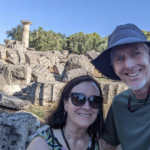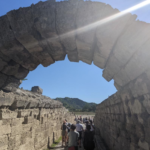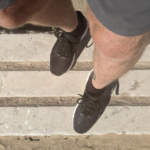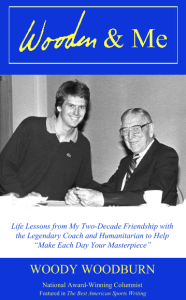 Zeus was the God of the Sky in ancient Greek mythology, so it seemed like a smile from the heavens to visit Greece’s Olympia ruins – including the Temple of Zeus – under a cloudless sky as blue as the nearby Ionian Sea.
Zeus was the God of the Sky in ancient Greek mythology, so it seemed like a smile from the heavens to visit Greece’s Olympia ruins – including the Temple of Zeus – under a cloudless sky as blue as the nearby Ionian Sea.
Adding a divine wink, my wife and I were there on an early September day, the exact time on the calendar the original Olympics were held beginning in 776 B.C. Still, it was difficult to imagine these historic grounds in their former glory because all that remains are toppled stone blocks scattered about like colossal headstones in a cemetery of disrepair.

Among the ancient ruins at Olympia with Lisa.
One area, however, does remain largely as it once was: the track stadium. Visitors today can even use the special entrance, called the Krypte, with its stone archway still intact overhead. To be honest, however, the stadium that awaits across this threshold is underwhelming. Unlike the breathtaking Colosseum in Rome, some 300 miles due south, Olympia’s “stadium” had no seating structure. Instead, two grass slopes rising up gently the full length of the track on both sides provided Standing Room Only for 45,000 spectators.
The dirt track is not an oval but rather a long-and-narrow drag strip measuring just over half the width, and nearly twice the length, of a modern football field. Start and Finish lines of white marble mark off a distance of 192 meters – called a “stade” – with races ranging from a sprint of one length to 24 up-and-backs equaling nearly a three miles.

The “Krypte” entrance used by ancient Olympic athletes.
Before competing in footraces, as well as events later added such as the long jump, javelin, wrestling, and boxing, athletes rubbed olive oil over their bodies and then dirt.
“Other than a dusty sheen,” noted our tour guide, Nicolette, a sandy blonde whose olive skin was undusted, “they competed fully nude.”
A javelin toss from the track’s Krypte was Olympia’s most important building, The Temple of Zeus. Nearly a matching bookend of the Parthenon in Athens, the temple had 38 limestone columns, each 30 feet high, surrounding the perimeter and supporting a marble-tiled roof that shone as white as a full moon. The centerpiece inside was a 40-foot tall statue of Zeus, made of copper and bronze and covered with gold, and considered one of the Seven Wonders of the Ancient World.
The statue was stolen in the 5th century and later destroyed in a fire. Seven decades later, the temple was fully razed by a pair of earthquakes. Standing among the present rubble it is again hard to envision the glory that once rose here.

The historic starting line made of marble…
Speaking of glory and imagination, at the track visitor after visitor toed the two-foot-wide, inch-high marble starting line posing in runners’ crouches to have their photographs taken. More than a few let their visions run further, literally, by bolting into sprints as if a starter’s call had just bellowed.
Most of these Olympic daydreamers were men of middle age or older. One even shuffled with a quad cane. Not surprisingly, their initial dashes typically slowed to a jog by the halfway mark and became a walk for the return stade.
Invariably, except for the gentleman with the cane, the competitors resumed a sprint for the final 10 meters or so, always beaming as if the champion’s olive wreath was up for grabs.
Watching them, for I did not join in, I could not help but smile as well – with thanks that they did not take their ancient Olympic daydreams so seriously as to run wearing only olive oil and dust.
To be continued next week with more about olive oil…
* * *
Essay copyrights Woody Woodburn
Woody writes a weekly column for The Ventura County Star and can be contacted at WoodyWriter@gmail.com. Follow him on Twitter and Instagram at @woodywoodburn. His SIGNED books are available at www.WoodyWoodburn.com.

 Personalized Signed copies of WOODEN & ME: Life Lessons from My Two-Decade Friendship with the Legendary Coach and Humanitarian to Help “Make Each Day Your Masterpiece” and “Strawberries in Wintertime: Essays on Life, Love, and Laughter” are available at WoodyWoodburn.com
Personalized Signed copies of WOODEN & ME: Life Lessons from My Two-Decade Friendship with the Legendary Coach and Humanitarian to Help “Make Each Day Your Masterpiece” and “Strawberries in Wintertime: Essays on Life, Love, and Laughter” are available at WoodyWoodburn.com
